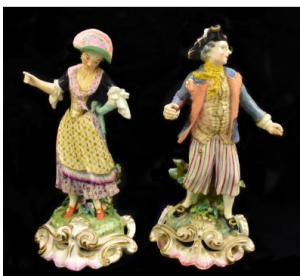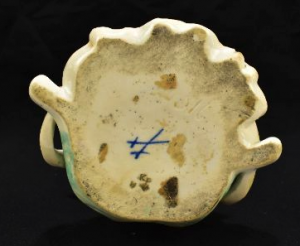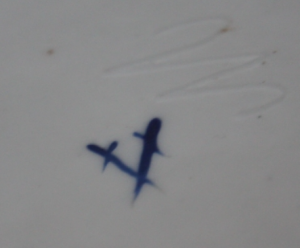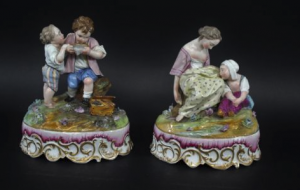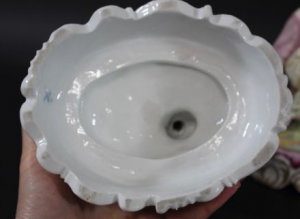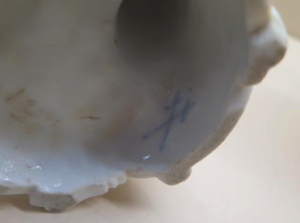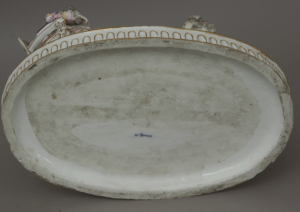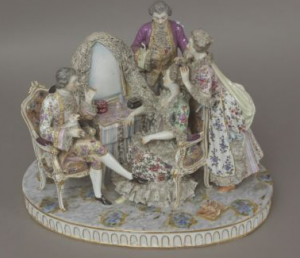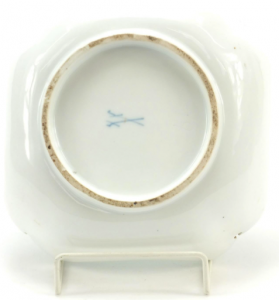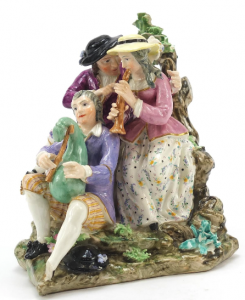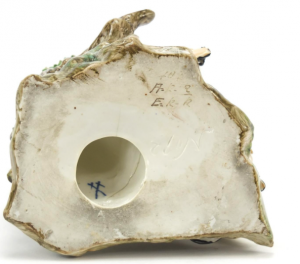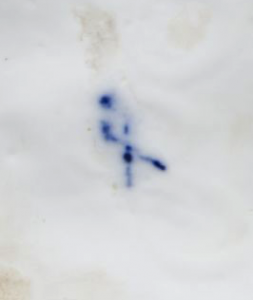
- Meissen Fraud; the Art of Deception
- The featured vases together with the spurious crossed swords mark above recently came up at an auction catalogued as Meissen. Read on to find out all about Meissen Fraud.
- It can be said the art of deception or fraud has been going on for a millennia. From the very first moment people started acquiring possessions others have sought to copy and deceive for profit. Move forward to the present day and this means in some cases the only way of telling the difference between fake and genuine is by scientific process. Sadly Meissen porcelain that not been exempt from deception or fraud and too succumbed to this fate. Therefore is you are a novice whose interest is collecting genuine Meissen you have only two choices where to make your purchases; the specialist dealer or auction salesrooms who have specialist departments who have many years of experience of handling Meissen Porcelain.
Buy from one of the many thousands of smaller salesrooms or dealers who do not have this experience you maybe building up a collection of fakes.
The earliest know evidence of Meissen fraud occurred when the Dutchman Claude Innocentius Du Paquier enticed two Meissen employees Christph Conrad Hunger and Samuel Stoltzel both of whom knew the secret of the arcanum to set up a factory in Vienna in 17019; however none of their pieces were marked although some of the designs on the earliest pieces are sometimes confused with Bottger porcelain.
Fortunately for Meissen on the 8th of November 1722 the factory inspector Johann Melchior Steinbruck proposed the use of the electoral swords from the coat of arms of the Electorate of Saxony as a factory mark. Initially the crossed swords mark was used in conjunction with the company’s monogram KPM (not to be confused with the 19th century Berlin KPM) Konigliche Porzellan Manufaktur or KPF ( onigliche Porzellan Fabrik).
By the 19th century The Meissen Crossed Swords Trade mark ibecame the most copied trade mark found on any type of European porcelain. Only ceramic wares bearing reign marks of the Chinese Imperial Dynasties Ming and Ching were produced in such high quantities with intent to deceive. However the majority of people living in China were impoverished with only a minority being Merchants or had some form of status within the Chinese Aristocracy or connected to the Monarchy.
At the beginning of the 19th century there were purported to be as much as 50 million workers producing Chinese Ceramics; this many one can just begin to appreciate the massive ceramic making in China.
Over the past decade more Chinese porcelain fakes have appeared on the market than the previous century is how much of a market there is for deception. This is due to the very high prices original pieces of imperial porcelain can achieve at auction; improvements in the art of faking; and the intense competing with selling fakes.
At The Meissen Man expect to see many variations of the crossed swords marks. Unless otherwise specified as different, the majority of variations are genuine. The only way of recognising the numerous genuine variation from as many fakes is spending years handling and acquiring knowledge to recognising the genuine article from the fraudulent ones. But even in the area of fraud comes with it complexities as amongst the many hundreds of smaller porcelain painters and makers attempted to make a living by creating their own versions of the cross swords mark in the vicinity of the two major porcelain makers in Dresden and Paris from 19th century onwards.
The best lesson that can be learned; whenever there is uncertainty that a cross swords mark is not genuine the likelihood is that it is fake; a later 19th century; or a copy of a Meissen original. Detecting original and fake can even get more complicated because major ceramic manufacturers needed to make profit to survive and in doing so they cut corners. This was evident at the two most influential porcelain manufacturers in Europe at Meissen and Sevres on the outskirts of Paris. The management produced Blanks. these were genuine pieces produced with just their first glaze onto of the bare porcelain. These pieces were produced in their tens of thousands and if not more and without decoration. On purpose they were sold off to smaller repairers (outside decorators).
Helena Wolfson in the middle of the 19th century was one such retailer who profited from buying pieces directly from the factory. However her trade in Meissen porcelain but selling as her own was genuine. Here is a prime example of the management at Meissen looking at ways to enhance their poor profits and thus created their own version of Meissen fraud.
Genuine Meissen articles bearing authentic cross swords marks were sold onwards for profit at a fraction of the normal price for painted wears . Few customers at this time were that experienced to understand the differences between Meissen painting and those that were outside decorated yet bore an authentic Meissen trademark.
The illustrations on The Meissen Man are here to help you widen your knowledge and hopefully learn the small differences between genuine and the fake. But to be able to grasp the art of deception this only became into the being after the Industrial revolution mechanised the making of porcelain. Whereas it is only 19th century Meissen that has been copied in bulk with Sevres vast quantities of original eighteenth century service wares were sold off undecorated and then redecorated from the middle of the nineteenth century for one purpose to deceive.
Today in the world of collecting the majority of pieces that turn up in auction worldwide are especially on websites like Ebay and smaller auction salesrooms or with dealers who are unable to distinguish authentic from fraudulent because of their lack of knowledge. Sevres in some ways is far more difficult to recognise genuine 18th century porcelain with contemporary painting. It takes many years of expert learning to recognise the differences. between the original painting and pieces that have been re-fired and re-painted later.
In Meissen’s case it would be easier to create an encyclopaedia of illustrations of copies of the Meissen cross swords mark than illustrating genuine cross swords mark where the novice collector or buyer and seller could genuinely recognise its originality.
The Meissen Man will be illustrating images of items offered for sale as genuine Meissen but are copies. It will be then up to you to learn. The challenge being; few copies are likely to be completely identical to the original Meissen.
Those items whose design has been copied with fake cross marks the only accurately way of recognising the real thing is by personally handling to gain experience.
For examples; see “Meissen fraud at Auction” in the chapter by scrolling down the page.
Examples illustrated are mostly taken from the 19th century since there are more availability of copies than 18th century examples.
The majority of these copies were made by the hundreds of inferior porcelain makers at Dresden or Paris. Only a minority attempted to emulate the turnover at Meissen. Most notable porcelain factories are those marked with the Dresden and the Paris Maker Samson. Helena Wolfson another prolific retailer selling Meissen look alike pieces had a genuine business relationship with Meissen. So much so that many of the smaller and inferior makers were envy of her success and even did their best to muddy the water further by copying Helena Wolfson’s style on porcelain that was original Meissen.
To the trained eye it was the style of painting that gives away the differences between the authentic Meissen of the period and those that are not.
The following images were all taken from a Meissen search at Auction and illustrates a good reason for the novice to only purchase from either a specialist dealer or auction salesroom that have a specialist ceramic department that can tell the difference between genuine and fake.
1: This pair of large Gardener figures that stand 40cm high are typical examples of pairs that were modelled in Paris. Some of these are sometimes attributed to the master Faker Samson. However Samson often signed his pieces with his own signature; a cross and not necessarily the spurious crossed swords marks that are found so often on inferior copies of genuine Meissen. In fact these were feeble attempts to copy Meissen but in the style of the many hundreds of inferior makers who tried to profit out of making their own copies hoping to fool their customers in believing they were purchasing original Meissen. The majority of these copies were made during the second half of the 19th century. For this pair to be genuine Meissen the bases would have to have wave type rococo borders in gilt and the points of the crossed swords be of matching length.
This figure of a Tailor sitting on a goat is after an original that is of Count Bruhl modelled as a tailor sitting on a goat. It is actually a very fine quality copy of a genuine Meissen original. The giveaway is the spurious cross as opposed to a crossed swords. No matter however Meissen’s crossed swords were ever poorly painted there were always pommels and sword tips and never painted as a cross. The other giveaway is the Coat of Arms next to the mark. While coat of arms appeared on Meissen as armorial’s this would always be apart of the painting and never by the Meissen trademark. Other giveaways on all of the original Meissen Tailor and Goats the crossed swords mark is always painted underneath the group between the goat’s four legs.. 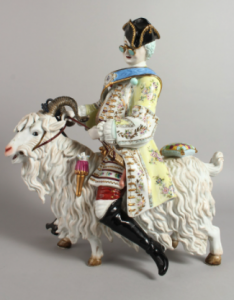
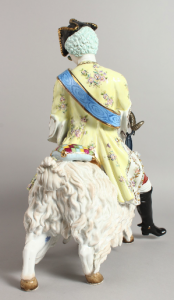
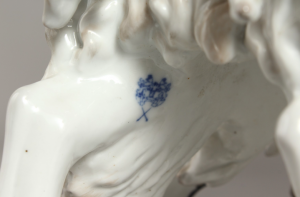
The following pair of groups are of a type that were made in Paris during the 2nd half of the 19th century. Much of the Paris based copies of Meissen were of a dull coloured glaze with very pale imitation crossed swords marks. The rococo style on the bases of both of these group is also incorrect as genuine Meissen the modelling would have been more refined and the rococo bases more shallow with brighter and thicker gilding. The spurious crossed swords appear more like a cross, another give away error that this pair could not be genuine Meissen.
The following pair of Vases might appear similar to genuine Meissen except they would have to copy the Meissen design accurately to stand any chance of being a refined copy. Thankfully this is not the case although the novice might be led to believe this pair are genuine Meissen since the crossed swords mark looks similar to the mark belonging to the period of Count Marcolini where a star appears below the pommels of the crossed swords mark. This pair are likely to be Dresden Copies of Meissen due to their similarities to the original design. Cupids are often seen embracing raised floral decoration. 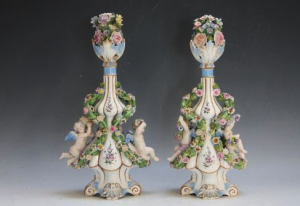
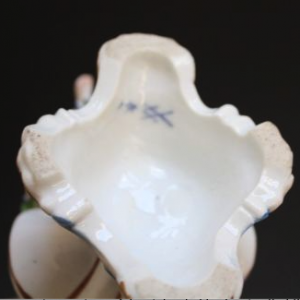
In all the years I have been a specialist in Meissen Porcelain I have never seen a any figures carrying baskets on their backs let alone a pair. If these were genuine Meissen which they are not they would be very rare indeed. The mark on these figures illustrates a period when Kandler was manager of the modelling department. Therefore the mark itself and the designs are both give aways. The dot period mark was mostly painted on porcelain in Paris and painted in pale blue. The ironic thing about the style of the mark is that it is a very good copy of the type of Meissen that was made in during the 2nd half of the 19th century and most certainly not in the middle of the 18th century that the mark is trying to emulate. Original Kaendler pieces would never have been made in such a clumsy style.
Towards the end of the 19th century the major Dresden porcelain makers were doing their best to compete with the vast faking enterprise in Paris. The modellers updated were constantly updating their style in their big to try to emulate the finer quality examples that the Meissen modellers were achieving. But there are notable differences between the very fashionable and brighter coloured pieces expected by the customers.
Copying Meissen by the middle of the 19th century was in full swing and Meissen Fraud was being spread around the world in huge numbers. These spurious factories numbered in their hundreds were aware that the Meissen factory had lost its dominance as being the pride of the European Porcelain Manufacturing trade and were doing their best to put Meissen out of business.
However the truth be known Meissen began losing its dominance after the seven years war in 1757 when the invading Russian Army inhabited the Meissen Factory. A 100 or so years later the fashion was to exploit copies of Meissen as much as possible.
Sadly when I first entered the world of specialising in 19th century Meissen all of the illustrations and far more were being offered for sale by the majority of auction salesrooms around the world that did not have the specialist departments that the larger auction salesrooms have today.
It saddens me that more auction salesrooms do not use my website to enhance their knowledge since the law today exists to protect the consumer. Hopefully more buyers and sellers can benefit from the updated site.
The following pair is of a type that was also copied in Italy during the beginning of the 20th century where other spurious potters tried to copy the style of Meissen. This pair were made in Dresden and while of good decorative looks the quality of the porcelain together with the modelling and painting is very unauthentic compared to the genuine article. The border around the base is very similar to the style by the artist Juchtzer who introduced the classical look during the Marcolini era whose mark a crossed swords with a star is seen under this piece. But again no examples of genuine Meissen made at the end of the 19th century appear with the Marcolini Mark.
The following vase whoever wrote the description should be ashamed of themselves. This is a type of porcelain produced in Bavaria. It was marketed to people who ran fairgrounds due to the cheapness of the quality of the porcelain no retailer would have wanted to offer for sale. This poor type of quality was made around 1900 and was more bisque or biscuit (unglazed porcelain) than appearing quality due to the lack of. Since the auction salesroom have not provided a photo of the mark I felt it was still worth discussing. 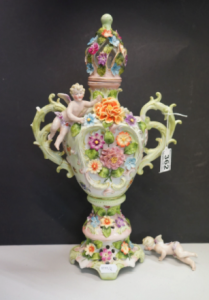
This illustration of a saucer bearing a genuine Meissen Mark has a more devious story attached to it. Meissen had throughout its history invited “repairers” to paint their porcelain. From as early as the years of Bottger while he had invented hard past porcelain what he had been unable to do without outside help is find the ideal solution to successfully paint colour onto his porcelain.
These repairers were in fact silver and goldsmiths who knew how to gild and apply their gilding to and colour to porcelain articles made at Meissen.
These repairers were unlike present day repairers who have acquired the art of restoring porcelain to look as good as new. The Silver and Goldsmiths seen in Meissen’s early years became known as Hausmalerai’s.
Artists who painted outside of the Meissen Factory.
The Meissen Deception Grows
During Meissen’s first 50 years of selling their porcelain wares the factory enjoyed the lack of competition. Even Du Paquier’s short reign did little in terms of competition. It was only after the seven years war in 1757 that Meissen began facing a growing battle by many other smaller German factories who had found new ways of manufacturing porcelain that was similar in taste to Meissen. Th differences being many bore their own styles with their own brand trademarks. The middle of the 18th century was an era opening up to new competition.
This new practice began spreading round Europe. The greatest threat to Meissen’s existence came from the French factory of Sevres, formerly Vincennes on the outskirts of Paris who at the time was the earliest threat.
In England the porcelain making factories of Chelsea and Worcester began experimenting with a different type of porcelain (soft paste). It was similar to the late 16th century porcelain maker Medici who spent ten years before they acquired the knowledge to turn clay into a single piece of porcelain.
But their soft paste there is a notable difference between the hard paste at Meissen.
Just like at Meissen the only decoration seen after the red wares were produced at Meissen other than pieces made without colour (in the white) was in blue and white and copied earlier Chinese designs.
Only 100 pieces of Medici Porcelain has survived. The only places you may find pieces are in the major museums such as the British Museum.
This short story tells you a little about the history of Medici and why it was short lived and why it is amongst the rarest of all porcelain’s ever made; (no doubt its a dealer’s dream as well as mine including to finding a genuine piece of Medici).
In England during the early 1740’s the English Factory of Chelsea was where were the first successful in making similar of a different type of porcelain known as soft paste. This type of porcelain was copied from the French Ceramic Maker of Saint Cloud in 1702.
Following on from Chelsea sprang forth porcelain makers of soft paste in Bow, Worcester, Bristol, Lowestoft, Plymouth and other smaller factories (Limehouse). Evidence of porcelain made in the vicinity of London shards can be found deposited along the shore of the River Thames.
Given that by the second half of the 19th century there was so much threat of competition to Meissen the management had to find new ways of marketing their porcelain and sold off vast quantities of marked and unmarked service wares.
This same process had been going on at the Sevres Factory since the 18th century. The majority of Sevres porcelain that is seen turning up around the world cannot be called genuine Sevres. Today it is against the law to call copies of Sevres authentic Sevres. This is because so much more of original 18th century Sevres with only their first glaze survived well into the 19th century. Many were purchased by bogus potters who repainted the Sevres porcelain imitating the 18th century design.
While at Meissen selling off vast quantities of unmarked or marked pieces in white it was inevitable that a business man would come along to illegally profit from purchasing large quantise of undecorated Meissen. Much of the attribution goes to Helena Wolfson. However it was her daughter who married a businessman that sought this devious opportunity. Sadly vast quantities of porcelain come up for sale in dealers stocks and Auction salesrooms who lack the the experience to realise what is being sold is not genuine Meissen but factories that bear the Helena Wolfson Trademark. The full story can be found here. It is therefore no wonder there is so much of Helena Wolfson being offered for sale as genuine Meissen porcelain.
Helena Wolfson Porcelain Helena led a rather unusual life in the world of Meissen fraud since she legitimately bought undecorated marked pieces of Meissen porcelain directly from the factory. Helena worked out of her shop in Dresden where she sold other porcelain, furniture and paintings. Therefore her talents originated from being the daughter of a retailer of Porcelain and furthering her career to include porcelain painting. Here her focus was painting scenes that were first produced after originals dating as far back to when the AR (Augustus Rex Mark) was introduced between 1720 and 1732.
Where Meissen fraud and the art of deception fits into the picture is the lack of understanding that she is the artist and not Meissen. Therefore pieces painted by her may have the mark but they are not authentic painted pieces by Meissen. For a piece of Meissen to be authentic it has to be both designed and painted at Meissen. This was quite a different scenario from the Hausmalerai who had Meissen’s permission to paint on the porcelain. A Dresden copy of a Meissen Plate.
Watteau scenes of lovers were amongst the most plentiful of Meissen designs in the 19th century, copied from originals made towards the end of the first half of the eighteenth century. Helena Wolfson a Dresden porcelain painter and manufacturer was the chief copier. For the most part she marked her pieces with the AR Mark. But sometimes it is found with a fake ‘cross swords mark.
The cross swords mark seen here was never painted in absolute straight lines as depicted on the reverse of this plate. For a plate to have ben original Meissen with the AR mark it would have had to be manufactured in the 1720’s. While on 18th century Meissen can be found cross swords marks similar to the mark on this plate, Watteau designs were not seen until the 1750’s and such a mark would have pre-dated the design. This plate dates from circa 1900. This salad bowl is painted by Helena bearing a mid 19th century Meissen Mark
The following saucer with a genuine Meissen crossed swords trademark is a good example of the style of decoration that is not only found on service wares such as cups and saucers, plates, bowls, teapots, trays but also vases etc and painted in all the major colours of a rainbow. 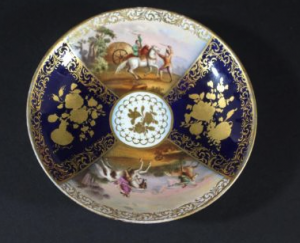
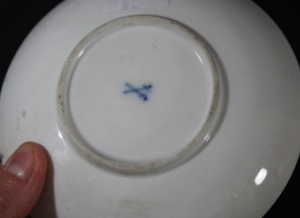
Meissen Fraud in England. Meissen fraud does not exist in the official sense since in England. The majority of porcelain that was made was painted in the style of Meissen or after Meissen Designs with trademarks belonging to the English porcelain factories.
However the Worcester factory circa 1750-60 began adopting their own version of the cross swords mark. The soft paste being the main difference when it comes to recognising the differences between Meissen’s hard past. Only a fraction of the Worcester wares bare the Meissen trademark and the majority of pieces are seen in blue and white.
During the 19th century many English potters attempted to emulate the Meissen Trade Mark.
The following pair of figures were made at the Derby Factory at the end of the 18th century. However the design and style is Derby and not that of Meissen. But the use of the crossed swords can be easily confused with that of Meissen. Although at the time the pair of figures were made at Meissen would have been during the Marcolini Period and had the figures been marked with the Marcolini Mark a star between the scabbard then indeed confusion could arise. The catalogue description of the following lot res Meissen Porcelain. However the group is actually Derby. The give away sign is the letters/numbers Incised into the base is part of the Derby factory’s signature. Had this been authentic Meissen it is unlikely you would find the crossed swords mark painted inside the hole in the base.
The pair of figures illustrated below are also by Derby circa 1830 This is a very good example of a fine copy of an 18th century Meissen Mark. However because it is painted on soft paste porcelain the actual appearance makes it look like an original mid 18th century mark as opposed to being similar to the marks used at Meissen from 1830 onwards. In terms of design Meissen never made rococo borders in the manner these figures are designed. Meissen bases would be more elegant with gilt rococo style borders navigating around the actual base where is painted in pink on these figures. 